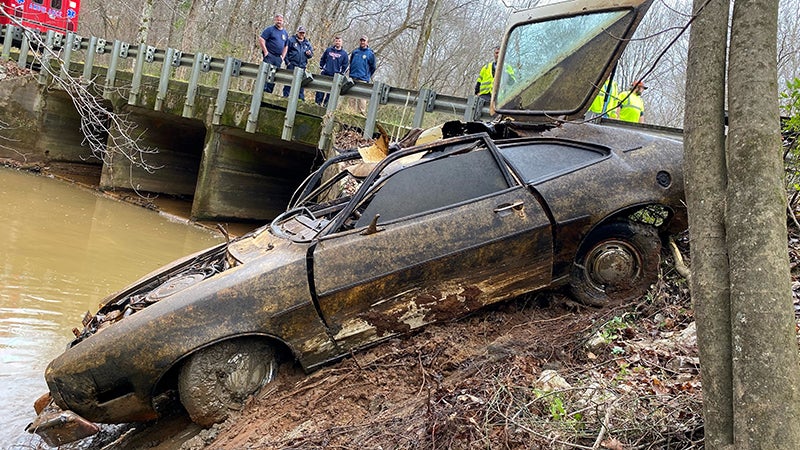Former Troup County Commissioner shows off postcard collection
Published 7:00 pm Thursday, March 28, 2019

- Chris Cleaveland (at right) was the guest speaker at Thursday’s noon hour meeting of the West Point Rotary Club, held in the Hampton Inn & Suites River Room. He talked about his Vanishing West Georgia website and showed slides of his vintage bottle and postcard collection. At left, is Gus Darden, the club president. Also pictured is Greater Valley Area Chamber of Commerce President Bill Gladden.
LANETT — On Wednesday, members of the West Point Rotary Club were treated to a presentation by LaGrange history buff Chris Cleaveland, who had a slide presentation of vintage postcards from West Point and the Valley area, plus some rare bottles he’s collected over the years that have an interesting local connection.
A former Troup County commissioner, Cleaveland recently retired from the LaGrange office of CharterBank (now CenterState Bank). He has a Facebook page titled Vanishing West Georgia. Cleaveland likes to joke that he and his wife literally spent their first night together. They were born in the same hospital on the same day and each spent that first night in the nursery.
Cleaveland started his post card collection when he was young. He got six of them for 25 cents each and out of curiosity showed them to his grandfather.
“He knew everything about them, the names of the businesses and who ran them,” he said, explaining that the postcards were of historic scenes in downtown LaGrange. The elder Cleaveland was with the Cleaveland-Dodd Company, a well-known LaGrange business at the time.
The younger Cleaveland learned that old postcards made for good conversations with people who knew a lot about the past.
“The golden era for postcards was from 1880 to 1920,” he said. “This was during a time before the widespread availability of telephones. People would purchase them in downtown drug stores and bookstores.”
Most postcards were made from black and white photographs. They were colored by the printer and sometimes didn’t get the colors right. A building that looks red on a postcard, for example, might not be that color.
One of the rarest postcards Cleaveland has is the scene of downtown West Point flood.
“It’s the only one like this I’ve ever seen,” he said. “I think it must have been 1912, judging from the cars in the picture.”
Other postcards show such historic scenes as the Charles Hotel (later the General Tyler), the three-story Lanier Building, an A&WP steam engine, the A&WP band and a 1909 image of the West Point Methodist Church.
Located on the corner of West 3rd Avenue and West 8th Street, the Lanier Building had three stories prior to the 1920 tornado that devastated the downtown area, ripping away the top-floor Opera House.
“The A&WP Railroad had their own band,” he said. “They traveled up and down the line playing at different locations.”
Cleveland’s bottle collection includes one from Askew’s Drug Store in downtown West Point. Mr. Askew was one of the victims of the tornado. He was working in his pharmacy on that Sunday afternoon when the tornado cut a path over north Lanett and downtown West Point.
One of his rarest bottles dates to 1871 and is stamped “Abbott’s Liver Medicine, West Point, Georgia.”
“It’s the only one of its kind I know of,” Cleaveland said.
He also has a Hutchinson bottle from early West Point. These very rare bottles were once used by the Coca-Cola Company. He has another one with “Shawmut Milk” stamped on it, possibly from Word’s Dairy. There’s another one with the lettering, “Batson Lake Dairy, West Point, Ga.”
One of his favorite postcards is of West Point High School from around 1930.
“My grandfather graduated from that school,” he said. “His family lived in the Salem community and West Point was closer than LaGrange.”
One of the West Point cards includes the Griggs House, noting that a Civil War cannonball was lodged in one of its walls.Cleaveland’s collection includes color depictions of all of the historic mills in the Valley – Lanett, Shawmut, Langdale, Fairfax and River View.
The Shawmut Milk bottle is an example of a ghost town bottle.
“There’s no town on the map anymore known as Shawmut,” Cleaveland said.
Of course, the Shawmut community is very much a part of Valley.
Cleaveland’s Vanishing West Georgia site gets lots of activity. One recent week it got 52,000 hits.
One of the more interesting images on the site is the Mort Kunstler painting of Col. Oscar LaGrange’s Wisconsin Calvary being confronted by the Nancy Harts in LaGrange. Kunstler is a renowned painter of scenes from the Civil War. A New York City native, Kunstler is now in his 90s. The Nancy Harts painting is the last one he painted before retirement in 2015.
“He did a great job of it,” Cleaveland said. “So much of the detail in it is accurate.”
A house in the background is still there. It’s located on the corner of Broad Street and Springdale near the campus of LaGrange College. It’s thought to be the location where an armed group of LaGrange area women stood their ground on an April day in 1865 and urged the Union cavalry not to burn anyone’s home.
Legend has it the women chose not to fire after seeing the Union soldiers had Confederate prisoners, mostly boys and old men who had been captured when Fort Tyler fell.



